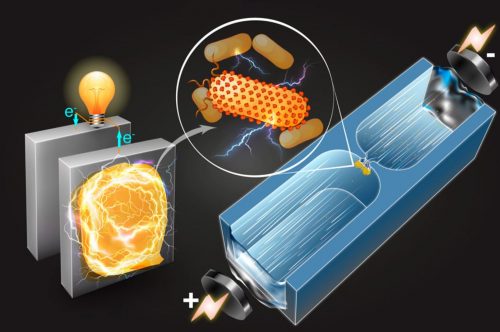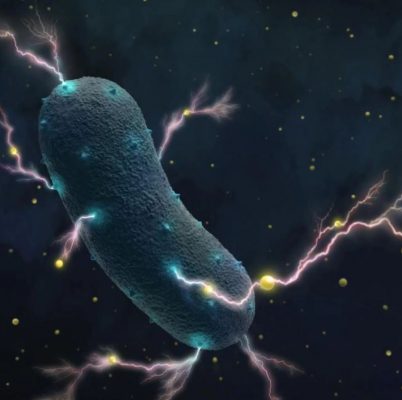
A team of researchers has developed a technique that identifies electricity-producing bacteria. They screen the microbes with a new microfluidic process. The scientists say that their technique may have potential uses in environmental cleanup and power generation.
MIT researchers, along with colleagues from the University of Minnesota Twin Cities, and the University of California, Berkeley, wrote about their work in the journal Science Advances (citation below). The authors were Qianru Wang, A.-Andrew D. Jones III, Jeffrey A. Gralnick, Liwei Lin, and Cullen R. Buie.
Electricity-producing bacteria have adapted
Microbes that exist in extreme conditions often find creative ways to adapt. Some types of bacteria live in oxygen-deprived environments. In other words, they must find a way to breathe without using oxygen.
These bacteria, which exist at the bottom of lakes and deep within mines, excrete and pump out electrons. In other words, they are electricity-producing microbes. Electricity-producing bacteria also exist in the human gut.
Researchers today are exploring ways to harness these microscopic power plants to purify sewage water and run fuel cells. They are also exploring some other uses.
However, pinning down their electrical properties has been extremely difficult. The cells are significantly smaller than mammalian cells. They are also very difficult to grow in the lab.
Assessing the activity of electricity-producing bacteria
In this latest study, researchers have developed a microfluidic technique that can rapidly process small samples of bacteria. It can also gauge a specific property that is closely correlated with their ability to produce electricity.
We refer to this property as ‘polarizability,’ the authors explained. It can be used to assess the electrochemical activity of electricity-producing bacteria more efficiently than current techniques. This new technique is also safer.
Qianru Wang, a Postdoctoral Associate at MIT’s Department of Mechanical Engineering, said:
“The vision is to pick out those strongest candidates to do the desirable tasks that humans want the cells to do.”
Cullen Buie, an Associate Professor of Mechanical Engineering at MIT, and also the Esther & Harold E. Edgerton Career Development Chair, said:
“There is recent work suggesting there might be a much broader range of bacteria that have [electricity-producing] properties.”
“Thus, a tool that allows you to probe those organisms could be much more important than we thought. It’s not just a small handful of microbes that can do this.”

Electricity-producing bacteria generate electrons internally
Electricity-producing bacteria produce electrons within their cells. They then transfer those electrons across their cell membranes through minuscule channels that surface proteins form. We call this process EET (extracellular electron transfer).
Current techniques for gauging the electrochemical activity of bacteria involves cultivating large batches of cells and measuring EET protein activity. This is a very time-consuming and meticulous process.
Other techniques involve rupturing the cell, which subsequently purifies the protein. Prof. Buie sought a less destructive and faster method to gauge bacteria’s electrical function.
Prof. Buie’s team
For the past decade, his team has been building microfluidic chips etched with tiny channels. Microliter-samples of bacterial flow through the channels. Each channel is pinched in the middle, thus giving it an hourglass configuration.
When electricity is applied across a channel, the pinched section puts a squeeze on the electric field. This subsequently makes it one-hundred times stronger than the surrounding field. The pinched section is approximately 100 times smaller than the rest of the channel.
The electric field’s gradient creates a force that pushes the cell against its motion that the electric field induced. We call this phenomenon dielectrophoresis. As a result, dielectrophoresis can stop a particle in its tracks or repel it at different applied voltages, depending on the properties of the particle’s surface.
Prof. Buie and other scientists have used dielectrophoresis to rapidly sort bacteria according to size, species, and other properties. This time, Prof. Buie wondered whether he could use the technique to suss out the electrochemical activity of electricity-producing bacteria.
Dr. Wang said:
“Basically, people were using dielectrophoresis to separate bacteria that were as different as, say, a frog from a bird, whereas we’re trying to distinguish between frog siblings – tinier differences.”
Comparing different electricity-producing bacteria
In this latest study, the scientists used their microfluidic setup to compare different strains of electricity-producing bacteria. Each strain had a different, known electrochemical activity.
The strains included several that the scientists had genetically engineered. There was also one ‘wild-type’ or natural bacterial strain that actively produced electricity in microbial fuel cells.
The researchers were trying to determine whether a correlation existed between a bacterium’s electrical activity and how it behaved in a microfluidic device. Specifically, under a dielectrophoretic force.
According to MIT News:
“The team flowed very small, microliter samples of each bacterial strain through the hourglass-shaped microfluidic channel and slowly amped up the voltage across the channel, one volt per second, from 0 to 80 volts.”
“Through an imaging technique known as particle image velocimetry, they observed that the resulting electric field propelled bacterial cells through the channel until they approached the pinched section, where the much stronger field acted to push back on the bacteria via dielectrophoresis and trap them in place.”
Calculating cell’s polarizability
Some bacteria were trapped at lower and others at higher applied voltages. Dr. Wang noted down the ‘trapping voltage’ of each bacterial cell and measured their cell sizes. She then calculated the cell’s polarizability with a computer simulation. In other words, she calculated how easy it was for cells to form electric dipoles in response to external electric fields.
The more electrochemically active bacteria tended to have a higher polarizability, Dr. Wang discovered. This correlation existed across all species of bacteria, she added.
Dr. Wang said:
“We have the necessary evidence to see that there’s a strong correlation between polarizability and electrochemical activity.”
“In fact, polarizability might be something we could use as a proxy to select microorganisms with high electrochemical activity.”
Dr. Wang said that they could gauge bacteria’s electricity production by measuring their polarizability. At least for the strains they measured.
This is something that researchers can track efficiently and easily using their microfluidic technique. They can also do it non-destructively.
Testing new strains
The researchers are currently using their method to test new bacteria strains. Specifically, strains that they have identified has electricity-producing bacteria.
Dr. Wang said:
“If the same trend of correlation stands for those newer strains, then this technique can have a broader application, in clean energy generation, bioremediation, and biofuels production.”
Biofuels are fuels produced from renewable biomass material.
Funding for this research came partly from the National Science Foundation and the Institute for Collaborative Biotechnologies, through a US Army grant.
Citation
“Microfluidic dielectrophoresis illuminates the relationship between microbial cell envelope polarizability and electrochemical activity,” Qianru Wang, A.-Andrew D. Jones III, Jeffrey A. Gralnick, Liwei Lin, and Cullen R. Buie. Science Advances, 11 Jan 2019: Vol. 5, no. 1, eaat5664. DOI: 10.1126/sciadv.aat5664.
